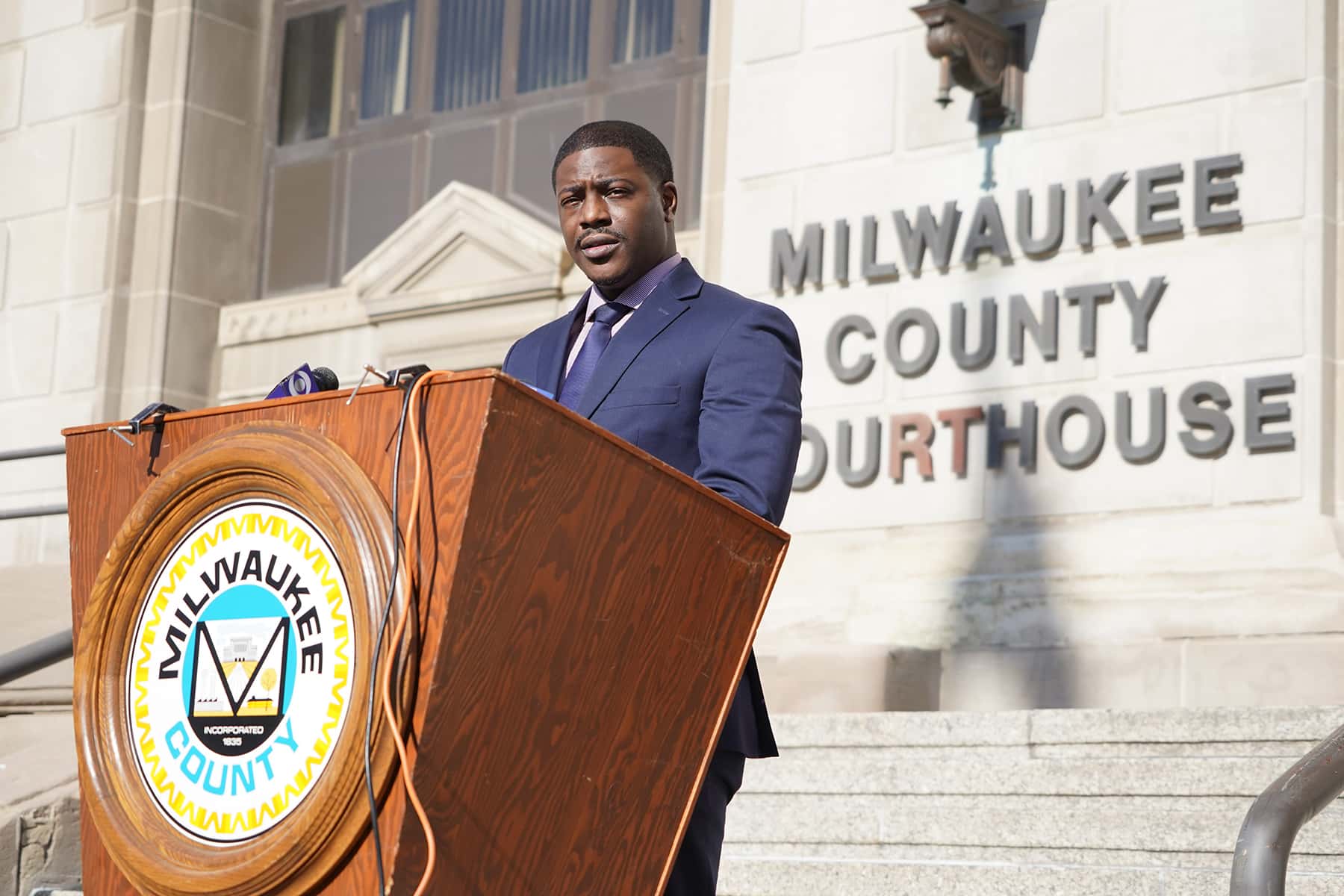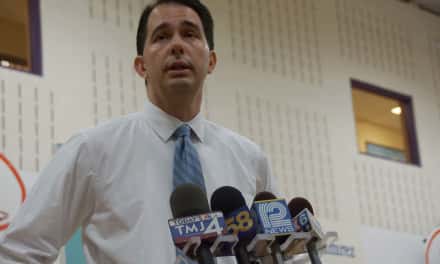
David Crowley presented the 2021 State of the County address on February 24, his first as Milwaukee County Executive. The main topics included investments in transportation, mental health services, and measures needed to resolve racial disparities while enduring the pandemic. This is the text of his speech as written and delivered.
Ladies & Gentlemen of Milwaukee County, County Supervisors, Elected Officials, members, and others watching – it is an honor to present the 2021 State of the County address.
As we come to an end of a month of celebrating Black History and honoring the accomplishments of those who’ve come before us, I am thrilled to speak on the future of Milwaukee County and celebrate the victories in equity we’ve achieved together so far.
Welcome, and thank you for tuning in this afternoon.
I’d like to begin by respectfully acknowledging where we reside here at the Milwaukee County Courthouse: on traditional Potawatomi, Ho-Chunk, and Menominee homeland right on the southwest shore of Michigami.
For more than five hundred years, Native communities have demonstrated incredible resilience in the face of violent attempts to separate them from their land, culture, and history. We acknowledge that we stand on land taken from its rightful stewards as a small, but necessary gesture toward honoring our Native brothers and sisters.
Generations of our Native residents have been left out of the picture when we think of Milwaukee County. It is my hope that through our vision for Milwaukee County we can repair the relationship with our Native residents and help tell the true story of our Native communities.
Today, it’s an honor to deliver the State of the County address because we’ve faced unprecedented challenges in the last year. But in the face of adversity I’ve seen our community come together to lift one another up, keep each other safe, and give us all reason to be optimistic about the upcoming year.
In these times, we must hold on to what brings us together. It can feel like we’re alone at times, especially with the physical distances in-between us, but we’re not alone. We’re in this together as one Milwaukee County. As one state of Wisconsin. We all have a stake in Milwaukee County’s future. And when we lift-up our most vulnerable neighbors and prioritize communities who have been historically marginalized, we all benefit. The only way we will bounce back from this pandemic is by investing in equity and fixing the systems that brought us here in the first place. By achieving racial equity, Milwaukee will be the healthiest County in Wisconsin.
One year ago, in February of 2020, our state was grappling with the first cases of COVID-19.
The pandemic continues to rage on today, and the impact has been over 1,000 deaths and more than 96,000 total cases confirmed in Milwaukee County alone. This week, the nation passed the grim milestone of over a half million COVID-19 related deaths. These aren’t just numbers on a dashboard, these are real people — our fellow Americans who we’ve tragically lost over the last year – our health care workers, educators, first responders, students, veterans, community elders, and people from every walk of life. They were parents, siblings, children, friends, coworkers – and they will be loved and missed.
I’d like to ask everyone with us today to join me in a moment of silence to honor the lives we’ve lost to COVID-19. Thank you.
Throughout the year, we’ve mourned and grieved the loss of our fellow Wisconsinites, but we haven’t given up the fight against the disease.
By now we are all familiar with the dramatic disparities highlighted by the pandemic—whether it was early data showing disproportionate cases and deaths or the current low rates of vaccination for people of color.
The gaps we see in the health of our neighbors aren’t inevitable, they exist because of structural racism.
When discriminatory practices in one sector of our society support corresponding practices in other sectors, they create an interconnected structure of inequities in our laws and policies – otherwise known as structural racism. The consequence is that nearly every system in our society—from government to education to healthcare—supports practices that lead to discrimination and an unequal distribution of resources.
We see this structural problem play out in the distribution of vaccine. About 60 percent of the vaccine doses administered have been to White residents of Milwaukee County. This follows statewide data showing nearly five times as many vaccinated white residents than vaccinated Black residents – and a national trend showing the percentage of Black people who received COVID vaccines is half or less than the proportion of black COVID cases.
Early priority groups have primarily been health care workers, long-term care residents, EMTs, police officers and firefighters – professions disproportionately held by white people. This is a result of systemic barriers existing before the emergence of COVID-19.
There are also a range of barriers to preventative healthcare, like vaccines, that existed for people of color before the pandemic. Those with time, money, internet access, and transportation are more likely to receive preventative care than those without.
We are seeing these two destructive forces, COVID-19 and structural racism, wreak havoc each day during the pandemic. That’s why Milwaukee County is committed to addressing the structural factors that contribute to this problem. The policies. The practices. The way our government prioritizes who gets what resources. We are not just responding to the problem in front of us. We are addressing the problems that have come from generations before us.
Let me be clear: if we do not address these structural problems now, we will see worsening disparities along racial lines long after this pandemic is over.
The data shows we have a lot of work still to do. But I’m proud of the resilience and commitment to our shared future we’ve all shown in the face adversity. Because of your determination and optimism, I’m pleased to report that the state of the county is stronger than any of us could have predicted in the early months of the pandemic this time last year.
Immediately following the declaration of a local public health emergency due to COVID-19, we formed the Unified Emergency Operations Center to coordinate a countywide response to the pandemic, preventing further spread throughout the community and safeguarding the health and wellness of the public.
County employees stepped up in big ways to continue serving our residents. The Milwaukee County Transit System implemented masking and distancing protocols to keep our buses running. Courts developed virtual hearing options. The Division of Aging developed a curbside meal pickup program, provided transportation for residents to essential medical appointments, and delivered over 8,500 meals to older adults.
Not only were we able to respond swiftly to the pandemic, but by working with the County Board and the leadership of Chairwoman Marcelia Nicholson we were able to set Milwaukee County on a course of change.
With the support of the County Board, we allocated over $77 million in federal CARES Act funds to invest in critical life-saving measures and economic support for Milwaukee County residents.
We invested more than $850,000 in 16 grassroots organizations identified by the Community Resilience Response Team – a group created during the pandemic to offer community-based guidance to the County’s regional COVID response.
Since the pandemic began, we have invested more than $18 million into eviction prevention and mortgage assistance. Black residents made up 83 percent of those receiving assistance, highlighting the deep disparities that existed in housing security even before the pandemic.
To provide shelter and care for individuals experiencing homelessness, the Housing Division worked with the faith-based community, City of Milwaukee, and the state, to create Clare Hall. This safe space provides shelter, medical care, and connections to wrap-around services. Thanks to the hard work of the Housing Division and its partners we now have the lowest street homeless count on record and some of our most vulnerable residents have the care they need.
To help residents stay afloat and get back to work, Milwaukee County invested $3.5 million in the Community Resource Navigator Program. More than 200 people have been hired to fill critical positions during the pandemic through the program. Of the recruited applicants, more than 80 percent identified as people of color and more than half were women.
Through a partnership with the Division of Youth & Family Services, Employ Milwaukee, and Running Rebels, 20 young people, ages 16 to 18, were able to participate in the Community Resource Navigator Program. 100 percent of the youth referred to the program were able to successfully complete program milestones.
The County also disbursed over $11 million in CARES funds through the Small Business Recovery Grant program to provide economic assistance to small businesses facing financial pressures associated with the pandemic. Over 1,500 businesses received grants, with 66 percent of businesses identifying as minority-, woman- or veteran-owned.
When it comes to our small business community, we know there is even more potential for meaningful changes to the system to give them an equal shot at success. To that end, we’re exploring how we can increase equity in the county’s contracting practices to give some of the most overlooked and undervalued small businesses a chance to succeed.
This is just one example of how we will tackle the systems that create inequity. Over the last year, we’ve shifted resources to change our policies and practices, and put into action the three focus areas of our strategic plan: Creating Intentional Inclusion, Bridging the Gap in health disparities, and Investing in Equity.
We know that change starts from within, that’s why we’re committed to providing a safe, open, and diverse workplace. We’ve continued racial equity training for all staff and expanded on the development of tools and resources for staff.
And, we continue to work across county department to improve operations, communications, and hiring practices.
We value having leaders at all levels of Milwaukee County government that closely reflect the county. I’m happy to announce that with the confirmations of Cassandra Libal as the Director of the Office of Emergency Management, Jeff Roman as the Director of the Office on African American Affairs, Shakita LaGrant-McClain as Director of the Department of Health and Human Services, and Chantell Jewell as the first Black woman as Superintendent of the House of Correction, more than half of Milwaukee County government leadership at the director level is Black and half are women.
Representation is important, not only to make sure the voices and perspectives of all our communities are heard, but also so the next generation of leaders can imagine themselves serving their community. We’re proud to have a top-notch team assembled at every level to guide us on our path toward health and to inspire the next generation of leaders to take us even further.
The Department of Health and Human Services has led the way in bridging the gap in health disparities by advancing a “No Wrong Door” model of customer service to create easier access to quality care. The No Wrong Door model increases the points of entry for residents, regardless of age or ability – in other words, there is no wrong door for someone to enter to receive needed services.
In this new model, DHHS Veterans Services has assisted more than 50 veterans in getting enrolled in VA Health Care, which allows these veterans aged 65 years and older to be eligible for the COVID-19 vaccine being administered by the VA.
We’ve also taken this whole-person approach when it comes to youth justice reform. We have invested in community-based youth services like the Credible Messenger Program, offering violence interruption and mediation, as well as an Achievement Center providing vocational services and work placements for youth.
Milwaukee County has evolved over the years, especially when it comes to locations of good-paying jobs, shopping destinations, schools, and residential areas. When it comes to creating a healthy community, providing access to reliable, quality public transportation is critical. In 2018, the Milwaukee County Transit System started working on a new approach to improve the rider experience and meet the community’s modern needs. The first phase of this project, called MCTS Next, takes effect on March 7 and will include benefits like more high frequency routes, better connections to job centers, grocery stores, and medical offices.
This project is a key piece of how we begin to physically transform our county through investing where resources are needed most. We can’t force our way off the list of most segregated communities in America, but we can make it easier for all of our residents to travel throughout the county and become connected to the diverse array of opportunities that exist beyond their own neighborhood. A more connected county means it will be easier for people to spend dollars in every part of the county and for others to access the job, training, and education opportunities they can’t find right outside their door.
Our Parks system is another way we’re working to connect our neighborhoods and meet community needs. This past summer, the Parks Department used county parks as staging locations for the We Care Crew – an effort to engage communities in public health education and necessary health care resources.
By way of the Milwaukee Community Justice Council, Milwaukee County is the recent recipient of a $1.3 million grant by the John D. and Catherine T. MacArthur Foundation to build on efforts to rethink the local criminal justice system, safely reduce the county jail population, and eliminate racial inequities. The grant brings the Foundation’s total investment in Milwaukee County to $5.6 million to date. I’m glad our work is being recognized in the form a continued partnership with the MacArthur Foundation to advance our overall vision.
Mental health is another critical component of community health, and we know the pandemic has made this more difficult. Since March of 2020, we’ve seen Emergency Medical Service calls related to mental health spike in response to the magnified stressors and pressures of the pandemic. And, calls by Black county residents make up 39 percent of total mental health related calls despite making up only 27 percent of the total County population.
Closing these disparities are driving our investments in this space. In addition to investing $1.6 million of CARES funding in mental health services, DHHS has worked to take the redesign of the Behavioral Health Department to the next level after years of assessment of community needs, research of national models, and input from both consumers and clinical providers. A new behavioral health hospital, Granite Hills, is scheduled to open later this year.
Recently, we announced a first-of-its-kind partnership with Advocate Aurora Health, Ascension Wisconsin, Children’s Wisconsin, and Froedtert Health to create a mental health emergency center, scheduled to open in the summer of next year, that provides a humane resource where individuals can go if they face a mental health emergency and receive care tailored to their needs.
The mental health emergency center is one of several necessary parts of the mental health continuum of crisis services that residents need. That’s why I was thrilled to see Governor Tony Evers include a $150 million proposal for mental health services in his 2021-2023 budget proposal.
The funds proposed could go a long way in building on our existing efforts to bring health care resources to traditionally underserved communities and explore other ways to increase access to care and quality of service for all. I’m hopeful that this is just the start of a productive series of discussions during the budget process that will lead to more resources for mental health services for local governments.
The financial challenges facing Wisconsin communities, including Milwaukee, are critical, widespread, and have a tangible impact on our ability to invest in local priorities and restrain unsustainable property tax growth.
In Wisconsin, counties are in a unique position relative to counties throughout the country, as they are required to provide local and state services with significant restrictions on the limited tools to fund those services. The most important tools we have are state aids and local property taxes.
Over the last decade, due to a series of difficult state budgets and competing priorities, state aids to local government have decreased, while the costs of state mandated services have grown. To compensate for the revenue shortfall, local governments have relied on property taxes to fund the increased cost of services.
Responding to declining state aid, state-imposed property tax levy limits, and a lack of alternative funding mechanisms, local governments relied on property taxes to fund local and state mandated services. Between 2006 and 2020 nearly 50 communities have approved binding referenda to increase property taxes to meet their local needs. The trend of overleveraging property taxes to pay for state mandates and local services is unsustainable for Wisconsin taxpayers and local governments.
In 2001, Governor Thompson’s Kettl Commission recognized the need to empower local governments to fund local investments with local resources. Nearly twenty years later, Governor Evers’ Blue-Ribbon Commission on Rural Prosperity reached a similar conclusion.
Over the past two decades, the urgency to secure a solution for local and state government has grown. Throughout the state, urban and rural communities recognize the bipartisan value of developing additional tools for local governments.
The pandemic has further highlighted the vulnerability of local governments’ ability to fund local services and amplified the urgency to secure a statewide solution to local government funding.
Milwaukee County values its role as the economic driver for the region and our state. More than 30 percent of the state’s economic output comes from metro Milwaukee, but we need the tools to make the necessary investments to continue growing and to create an environment that competes with other major metropolitan areas for investment and people.
As of the most recent data available, Milwaukee County’s growth has resulted in Milwaukee County taxpayers sending an additional $569 million to the state in 2018 than almost a decade ago, while at the same time the state returned $144 million less in state aids to Milwaukee County and its municipalities in 2017 than it did nearly a decade prior.
A local option sales tax would provide our residents a voice, and an ability to vote for a tool that allows us to capture the benefits of our own economic performance to invest in local priorities, while providing property tax relief.
Milwaukee County has undertaken significant efforts to improve the efficiency of our operations and pursued ambitious cost-savings efforts that generated a savings of nearly $289 million over the last 10 years.
Despite these efforts, the growing cost of state mandates will continue to drive up our costs by another $320 million by 2038. Continued expenditure reductions are not sustainable. We can’t cut our way out of this. In just six years, Milwaukee County will be forced to utilize all local tax dollars for state mandates, eliminating local funding for senior services, public safety, emergency services, disability services, bus routes and roads, along with cultural amenities including parks.
To ensure Milwaukee County continues driving the economy of the region and the state, to continue being a globally competitive region, we need the necessary tools to support investments and stability that will enable our community to provide high-value jobs and a vibrant quality of life for all.
The inclusion of a local option sales tax in the Governor’s budget proposal leaves me optimistic that there is room to work together and give counties the tools they need to provide property tax relief and fund their local priorities well into the future.
The future ahead remains uncertain, but there are opportunities just on the horizon to make significant gains toward racial equity and make county government work for all of our residents.
In order to bridge the gap in Milwaukee County’s health outcomes, we are committed to ensuring that our services meet the real needs of our community. To achieve this goal, we are examining every single service offered by Milwaukee County to ensure it advances our vision. In the upcoming months, we’ll gather data and engage with the community to understand both neighborhood assets and needs in order to compliment the good work being done in the community and to address the gaps in community needs.
For all you who are listening today, you have the power to help us ensure that we achieve our vision of health and racial equity. It took all us of to get through the last year and it will take us all working together to get through this year.
There are four things you can do right away to help Milwaukee County move forward:
The first is to share this speech on your social networks. I recognize that not everyone will able to watch the address live, but you can help your friends and family listen and learn by simply sharing the video with your social media pages. You can find the speech posted on the Milwaukee County Executive webpage, our Facebook page, and YouTube.
In addition, throughout the speech, our team has been posting links to COVID-19 relief resources, our race and health equity framework, and more to provide some context to the state of the county. Feel free to use these resources and share them with your networks. At Milwaukee County we’re having the important conversations about what it means to strive for racial equity, and we want to give you the tools to do so as well.
The second is to do all you can to support small businesses, especially Black, Indigenous, and People of Color owned businesses. I’ve spoken with many business owners in the County during the pandemic and they’ll all tell you the same thing: there is no bit of help that is too small right now. So, please, do what you can. Grab takeout one night this week, buy gift cards from your favorite spots around town for future presents, or consider donating to a worker or small business relief funds.
Third, is to continue to look at the people around you – especially at the leadership tables of organizations or workplaces. Do you see people of color? Do you seek out different opinions? How many? Think long and hard about whether the people who make the decisions in your sphere of influence represent the full diversity of Milwaukee County. Think, and most importantly, make an intentional plan to make the needed changes to achieve equity. I know I am.
And finally, I task you with recognizing and valuing the humanity in your Milwaukee County neighbors. The fallout from last month’s tragic events in the U.S. Capital is proof that the time is now for a shift in our collective thinking. We’re all Americans, we’re all Wisconsinites, we’re all members of the same county. We may have different opinions and views, but that doesn’t make us enemies.
The most patriotic thing we can do is look at those who disagree with us and continue to see them as a human being deserving of the same opportunities and rights as everyone else. Instead of fearing those we cannot understand and letting that fear divide us, doing the work to see the humanity in our neighbors is the work that is truly patriotic. It is the work that puts future generations first and prioritizes progress for all.
Milwaukee County decided to embark on a path toward racial equity because for too long we haven’t seen the humanity of every resident, and for too long we’ve neglected to meet the needs of every resident.
The purpose of our mission is to end generations of neglect by meeting the needs of everyone – regardless of their race, age, gender identity, or zip code. The victories we’ve already achieved on the road to racial equity are victories for us all. A more connected county through MCTS Next is good for workers, businesses, tourism and more. More streamlined health and human services means more residents can access what they need to ensure mobility, remain independent, and fully engage in life in Milwaukee County. Early intervention through programs like Credible Messengers set young people on a path to becoming an asset to their communities instead of a path that can lead them in the system. These are victories for us all.
To put future generations in the position to complete our journey, we must begin with seeing each other has human beings first – and we must begin now.
Before I conclude I want to thank once more the 4,000+ Milwaukee County employees for their tireless service helping to navigate in these unprecedented times and keeping the public safe.
I also want to send a special thank you to outgoing Director of the Milwaukee County Zoo, Chuck Wikenhauser, who announced his retirement after over 30 years of service. His work embodies the county mission statement: “We enhance the quality of life in Milwaukee County through great public service.”
We are beyond grateful for his decades of service and his work directing one of the top zoos in the nation. Thanks to Chuck’s steady and capable leadership, the County Zoo is well positioned to remain a place of enrichment, education, and entertainment for County residents and visitors alike.
Thank you, Chuck. We will miss you at Milwaukee County, and we wish you nothing but the best in retirement.
We made it through a difficult year and judging by the last two months this one looks to be every bit as challenging as the last. But this is a tough and resilient community, with residents known for rolling up their sleeves and getting to work when times get hard. The last year has shown us that the work is easiest when we share the load and work together to make sure our community’s needs are met. I’m optimistic we can come together once again to face the challenges ahead.
Please be safe. Thank you and God Bless.
© Photo
Lee Matz















